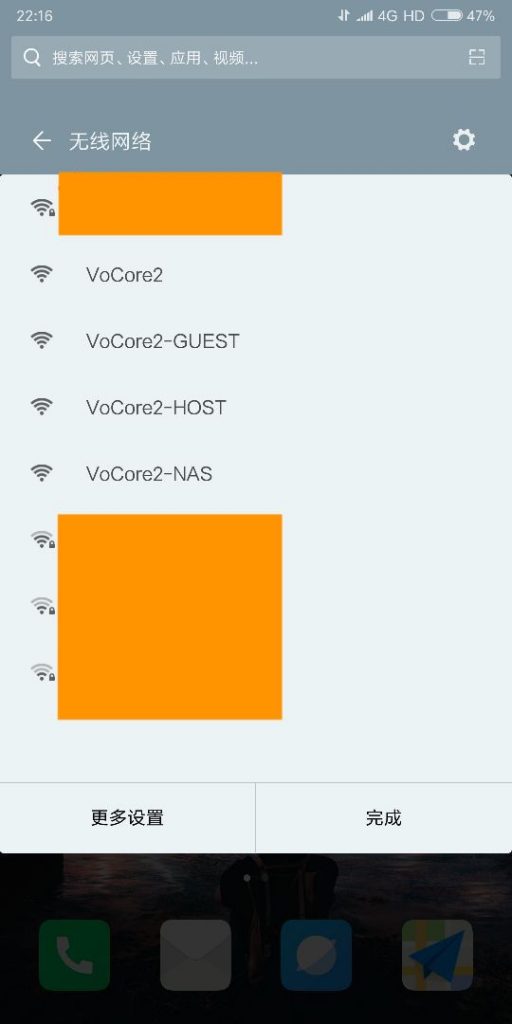Today when I hack the mt7628 driver, I find this hidden feature( maybe not hidden, but at least no documentation at all )
Example come first, if we want 4 different SSIDs in same VoCore2, need to setting up /etc/wireless/mt7628/mt7628.dat
This is only works for mediatek wifi driver mt7628.ko, not sure if mt76 works.
Modify BssidNum, set it to 4.
BssidNum=4
SSID1=VoCore2
SSID2=VoCore2-GUEST
SSID3=VoCore2-HOST
SSID4=VoCore2-NAS
Then reboot, you will find four raX device in your device list.
ra1 Available private ioctls :
set (8BE2) : set 1536 char & get 0
show (8BF1) : set 1024 char & get 0
get_site_survey (8BED) : set 0 & get 1024 char
set_wsc_oob (8BF9) : set 1024 char & get 1024 char
get_mac_table (8BEF) : set 1024 char & get 1024 char
e2p (8BE7) : set 1024 char & get 1024 char
bbp (8BE3) : set 1024 char & get 1024 char
mac (8BE5) : set 1024 char & get 1024 char
rf (8BF3) : set 1024 char & get 1024 char
get_wsc_profile (8BF2) : set 1024 char & get 1024 char
get_ba_table (8BF6) : set 1024 char & get 1024 char
stat (8BE9) : set 1024 char & get 1024 char
br-lan no private ioctls.
mon0 Available private ioctls :
set (8BE2) : set 1536 char & get 0
show (8BF1) : set 1024 char & get 0
get_site_survey (8BED) : set 0 & get 1024 char
set_wsc_oob (8BF9) : set 1024 char & get 1024 char
get_mac_table (8BEF) : set 1024 char & get 1024 char
e2p (8BE7) : set 1024 char & get 1024 char
bbp (8BE3) : set 1024 char & get 1024 char
mac (8BE5) : set 1024 char & get 1024 char
rf (8BF3) : set 1024 char & get 1024 char
get_wsc_profile (8BF2) : set 1024 char & get 1024 char
get_ba_table (8BF6) : set 1024 char & get 1024 char
stat (8BE9) : set 1024 char & get 1024 char
ra2 Available private ioctls :
set (8BE2) : set 1536 char & get 0
show (8BF1) : set 1024 char & get 0
get_site_survey (8BED) : set 0 & get 1024 char
set_wsc_oob (8BF9) : set 1024 char & get 1024 char
get_mac_table (8BEF) : set 1024 char & get 1024 char
e2p (8BE7) : set 1024 char & get 1024 char
bbp (8BE3) : set 1024 char & get 1024 char
mac (8BE5) : set 1024 char & get 1024 char
rf (8BF3) : set 1024 char & get 1024 char
get_wsc_profile (8BF2) : set 1024 char & get 1024 char
get_ba_table (8BF6) : set 1024 char & get 1024 char
stat (8BE9) : set 1024 char & get 1024 char
lo no private ioctls.
eth0.1 no private ioctls.
apcli0 Available private ioctls :
set (8BE2) : set 1536 char & get 0
show (8BF1) : set 1024 char & get 0
get_site_survey (8BED) : set 0 & get 1024 char
set_wsc_oob (8BF9) : set 1024 char & get 1024 char
get_mac_table (8BEF) : set 1024 char & get 1024 char
e2p (8BE7) : set 1024 char & get 1024 char
bbp (8BE3) : set 1024 char & get 1024 char
mac (8BE5) : set 1024 char & get 1024 char
rf (8BF3) : set 1024 char & get 1024 char
get_wsc_profile (8BF2) : set 1024 char & get 1024 char
get_ba_table (8BF6) : set 1024 char & get 1024 char
stat (8BE9) : set 1024 char & get 1024 char
ra3 Available private ioctls :
set (8BE2) : set 1536 char & get 0
show (8BF1) : set 1024 char & get 0
get_site_survey (8BED) : set 0 & get 1024 char
set_wsc_oob (8BF9) : set 1024 char & get 1024 char
get_mac_table (8BEF) : set 1024 char & get 1024 char
e2p (8BE7) : set 1024 char & get 1024 char
bbp (8BE3) : set 1024 char & get 1024 char
mac (8BE5) : set 1024 char & get 1024 char
rf (8BF3) : set 1024 char & get 1024 char
get_wsc_profile (8BF2) : set 1024 char & get 1024 char
get_ba_table (8BF6) : set 1024 char & get 1024 char
stat (8BE9) : set 1024 char & get 1024 char
ra0 Available private ioctls :
set (8BE2) : set 1536 char & get 0
show (8BF1) : set 1024 char & get 0
get_site_survey (8BED) : set 0 & get 1024 char
set_wsc_oob (8BF9) : set 1024 char & get 1024 char
get_mac_table (8BEF) : set 1024 char & get 1024 char
e2p (8BE7) : set 1024 char & get 1024 char
bbp (8BE3) : set 1024 char & get 1024 char
mac (8BE5) : set 1024 char & get 1024 char
rf (8BF3) : set 1024 char & get 1024 char
get_wsc_profile (8BF2) : set 1024 char & get 1024 char
get_ba_table (8BF6) : set 1024 char & get 1024 char
stat (8BE9) : set 1024 char & get 1024 char
eth0 no private ioctls.
eth0.2 no private ioctls.
apcli1 Available private ioctls :
set (8BE2) : set 1536 char & get 0
show (8BF1) : set 1024 char & get 0
get_site_survey (8BED) : set 0 & get 1024 char
set_wsc_oob (8BF9) : set 1024 char & get 1024 char
get_mac_table (8BEF) : set 1024 char & get 1024 char
e2p (8BE7) : set 1024 char & get 1024 char
bbp (8BE3) : set 1024 char & get 1024 char
mac (8BE5) : set 1024 char & get 1024 char
rf (8BF3) : set 1024 char & get 1024 char
get_wsc_profile (8BF2) : set 1024 char & get 1024 char
get_ba_table (8BF6) : set 1024 char & get 1024 char
stat (8BE9) : set 1024 char & get 1024 char
Now we can use every ra0, ra1, ra2, ra3 same time by one VoCore2. 🙂
And we can setting network, firewall to use them for guest, nas etc…
PS: it support up to 16 ssids, you need to modify its setting in the same file.
Have fun!
